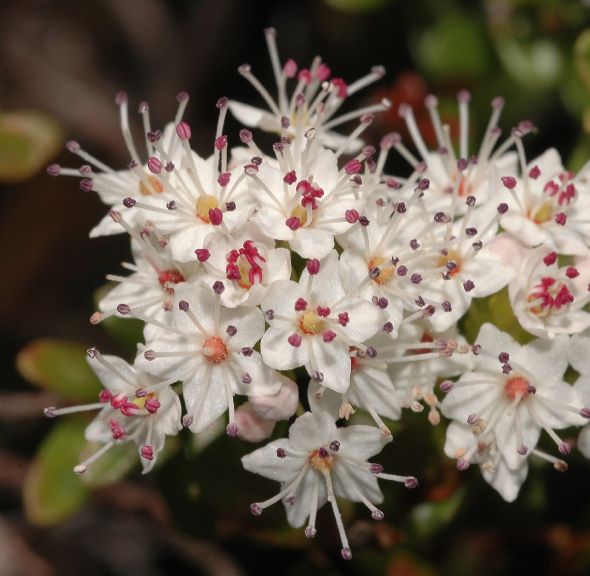Leiophyllum buxifolium ~ Mountain myrtle, Sand myrtle Plant Care Guide
“Most plants grow from their tips to add length. By contrast, grass grows from its base, emerging from a bud at, or just under, the soil surface, where sensitive growth tissues remain safe from the elements and hungry herds.” — Douglas Chadwick, The American Prairie, Root of the Sky, National Geographic, October 1993
ok this is and is not a plant care guide as there are no cultivated species of this plant, it is a wild flower of Tennessee and some other areas in North America. Some states it is an endangered species so please check your area if interested in having in your native garden, i am certain the DNR could help you.
| Leiophyllum buxifolium |
|||||||||||||||||||||||||||||||||||||||||||||||||||||||||||||
This species is found in three disjunct locations in the United States: the New Jersey Pine Barrens, the Coastal Plain of North and South Carolina, and the southeastern Blue Ridge Province. (Strand and Wyatt 1991) It has yet to be resolved if plants at these three locations are members of the same species, or different varieties. (Radford et al. 1968)Leiphyllum buxifolium, or sand myrtle, is an evergreen shrub, with adventitious roots (Small 1933, Gleason 1952, Hightshoe 1988, Foote and Jones 1994); it is in a monotypic North American genus (a genus consisting of a single species). L. buxifolium is placed in the family Ericaceae because of its pollen structure; however, its flower rather resembles species from the Diapensiaceae family. The hermaphroditic pinkish-white flowers are arranged in umbel-shaped clusters and bloom during May. This shrub is only 0.2-1 m tall and can grow erect, prostrate, or decumbent stems, in accordance with location or altitude. Its flowers are white or pinkish, arranged in terminal umbel-shaped clusters (Dirr 1998).
State Range
Habitat
Distribution
Number Left
State/Area Protection
Ecological Relationships
Threats
Current Research Summary
Current Management Summary
Research Management Needs
Ex Situ Needs |
|
References
|
|
Dirr, M.A. 1998. Manual of Woody Landscape Plants. Champaign, Illinois: Stipes Publishing L. L. C. |
||||||||||||||||||||||||||||
|
Foote, L.E.; Jones, S.B., Jr. 1994. Native Shrubs and Woody Vines of the Southeast. Oregon: Timber Press. |
||||||||||||||||||||||||||||
|
Hightshoe, G.L. 1988. Native Trees, Shrubs, and Vines for Urban and Rural America. New York: Van Nostrand Reinhold. |
||||||||||||||||||||||||||||
|
Radford, A.E.; Ahles, H.E.; Bell, C.R. 1968. Manual of the vascular flora of the Carolinas. Chapel Hill, NC: University of North Carolina Press. 1183p. |
||||||||||||||||||||||||||||
|
Small, J.K. 1933. Manual of the southeastern flora. New York, NY: Hafner Publishing Company. 1505p. |
||||||||||||||||||||||||||||
|
Kartesz, J.T. 1999. A synonymized checklist of the vascular flora of the U.S., Canada, and Greenland. In: Kartesz, J.T.; Meacham, C.A., editors. Synthesis of the North American Flora, Version 1.0. North Carolina Botanical Garden. Chapel Hill, NC. |
||||||||||||||||||||||||||||
|
(2000). Showy Native Trees, Shrubs and Woody Vines. [Web site] NC State University. http://www.ces.ncsu.edu/depts/hort/consumer/factsheets/native/scientific_namea-e.html. Accessed: 2002. |
||||||||||||||||||||||||||||
|
(2002). Leiophyllum buxifolium: Tour of Ericaceae Family. [Web site] American Rhododendron Society, Massachusetts Chapter. http://www.rosebay.org/chapterweb/index.htm. Accessed: 2002. |
||||||||||||||||||||||||||||
|
(2002). New York Metropolitan Flora Project: Metropolitan Plant Encyclopedia. [Searchable Web site] Brooklyn Botanic Garden. http://www.bbg.org/sci/nymf/encyclopedia/contents.htm. Accessed: 2002. |
||||||||||||||||||||||||||||
|
Kron, K.A.; King, J.M. 1996. Cladistic Relationships of Kalmia, Leiophyllum, and Loiseleuria (Phyllodoceae, Ericaceae) Based on RBCL and NRITS Data. Systematic Botany. 21, 1: 17-29. |
||||||||||||||||||||||||||||
|
Schuyler, A.E.; Gordon, T. 2002. Rare plants in the Middle Branch of the Forked River watershed, Lacey Township, Ocean County, New Jersey. Bartonia. 21: 117-121. |
||||||||||||||||||||||||||||
|
Strand, A.E.; Wyatt, R. 1991. Geographical variation and biosystematics of Sand Myrtle, Leiophyllum buxifolium (Ericaceae). Systematic Botany. 16, 3: 529-45. |
||||||||||||||||||||||||||||
|
White, S.P. 1983. Evidence that temperate east North American evergreen woody plants follow corners rules. New Phytologist. 95, 1: 139-146. |
||||||||||||||||||||||||||||
|
Morse, L.E. 1988. Rare Plants of Appalacian Bedrock. The Nature Conservancy Magazine: 38. |
||||||||||||||||||||||||||||
|
Clemants, S. 1998. Sand Myrtle Technical Page. Brooklyn, NY: Brooklyn Botanic Garden. p.2. Web page.
|
||||||||||||||||||||||||||||
*****************************
See Also ….
Name that Plant
Taylor’s Guide to Shrubs: How to Select and Grow More Than 500 Ornamental
Leiophyllum buxifolium Box Sandmyrtle ~ Ericaceae
Sand-myrtle (Leiophyllum buxifolium)
Sand Myrtle – Leiophyllum buxifolium PDF
Kalmia buxifolia
Mountain Myrtle, Sand Myrtle – Leiophyllum buxifolium ~ Wildflowers of US








Leave a comment